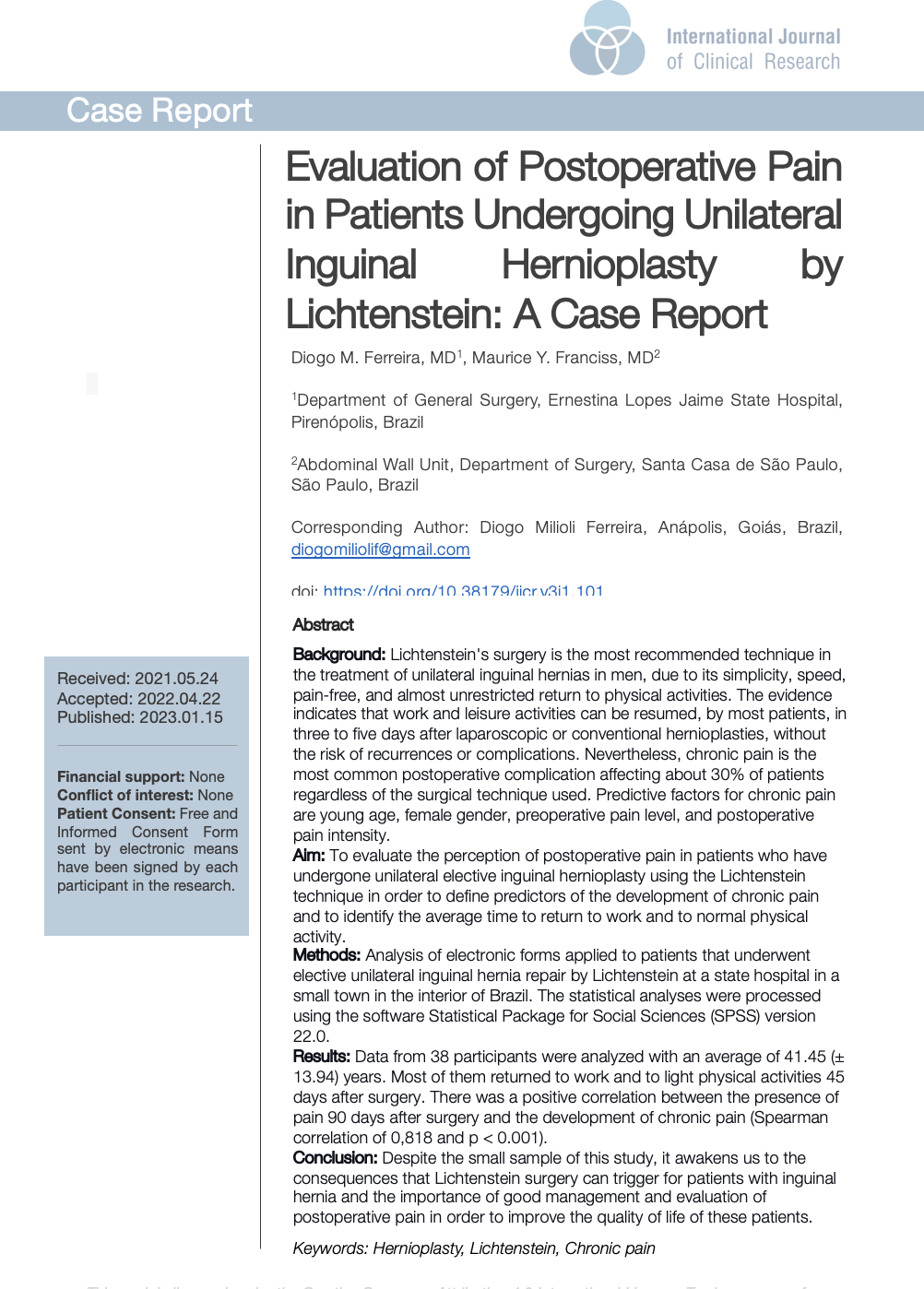Evaluation of postoperative pain in patients undergoing unilateral inguinal hernioplasty by Lichtenstein
DOI:
https://doi.org/10.38179/ijcr.v3i1.101Keywords:
Hernioplasty, Lichtenstein, Chronic painAbstract
Background: Lichtenstein's surgery is the most recommended technique in the treatment of unilateral inguinal hernias in men, due to its simplicity, speed, pain-free, and almost unrestricted return to physical activities. The evidence indicates that work and leisure activities can be resumed, by most patients, in three to five days after laparoscopic or conventional hernioplasties, without the risk of recurrences or complications. Nevertheless, chronic pain is the most common postoperative complication affecting about 30% of patients regardless of the surgical technique used. Predictive factors for chronic pain are young age, female gender, preoperative pain level, and postoperative pain intensity.
Aim: To evaluate the perception of postoperative pain in patients who have undergone unilateral elective inguinal hernioplasty using the Lichtenstein technique in order to define predictors of the development of chronic pain and to identify the average time to return to work and to normal physical activity.
Methods: Analysis of electronic forms applied to patients that underwent elective unilateral inguinal hernia repair by Lichtenstein at a state hospital in a small town in the interior of Brazil. The statistical analyses were processed using the software Statistical Package for Social Sciences (SPSS) version 22.0.
Results: Data from 38 participants were analyzed with an average of 41.45 (± 13.94) years. Most of them returned to work and to light physical activities 45 days after surgery. There was a positive correlation between the presence of pain 90 days after surgery and the development of chronic pain (Spearman correlation of 0,818 and p < 0.001).
Conclusion: Despite the small sample of this study, it awakens us to the consequences that Lichtenstein surgery can trigger for patients with inguinal hernia and the importance of good management and evaluation of postoperative pain in order to improve the quality of life of these patients.
References
Tabiri S, Russell KW, Gyamfi FE, Jalali A, Price RR, Katz MG. Local anesthesia underutilized for inguinal hernia repair in northern Ghana. PLoS One. 2018;13(11):e0206465. PMID: 30462684. https://doi.org/10.1371%2Fjournal.pone.0206465
Kingsnorth A, LeBlanc K. Hernias: inguinal and incisional. Lancet. 2003 Nov 8;362(9395):1561-71. PMID: 14615114. https://doi.org/10.1016/S0140-6736(03)14746-0
Rafiq MK, Sultan B, Malik MA, Khan K, Abbasi MA. Efficacy Of Local Anaesthesia In Repair Of Inguinal Hernia. J Ayub Med Coll Abbottabad. 2016 Oct-Dec;28(4):755-757. PMID: 28586585. https://jamc.ayubmed.edu.pk/jamc/index.php/jamc/article/view/648
HerniaSurge Group. International guidelines for groin hernia management. Hernia. 2018 Feb;22(1):1-165. PMID: 29330835. https://doi.org/10.1007/s10029-017-1668-x
Lichtenstein IL, Shulman AG, Amid PK, Montllor MM. The tension-free hernioplasty. Am J Surg. 1989 Feb;157(2):188-93. PMID: 2916733. https://doi.org/10.1016/0002-9610(89)90526-6
Teixeira FMC, Pires FPAA, Lima JSF, Pereira FLC, Silva CA, Paula MHS, Nobre DM. Estudo de revisão da cirurgia de hernioplastia inguinal: técnica de Lichtenstein versus laparoscópica. Rev Med Minas Gerais. 2017;27. http://www.dx.doi.org/10.5935/2238-3182.20170055
Lau H, Lee F, Poon J. Clinical factors influencing return to work after ambulatory inguinal herniorrhaphy in Hong Kong.
Ambul Surg. 2001 Jan;9(1):25-28. PMID: 11179710. https://doi.org/10.1016/S0966-6532(00)00069-X
Fortelny RH, Petter-Puchner AH, Redl H, May C, Pospischil W, Glaser K. Assessment of Pain and Quality of Life in Lichtenstein Hernia Repair Using a New Monofilament PTFE Mesh: Comparison of Suture vs. Fibrin-Sealant Mesh Fixation. Front Surg. 2014 Nov 28;1:45. PMID: 25593969. https://doi.org/10.3389/fsurg.2014.00045
Munro BH. Statistical Methods for Health Care Research. Wilkins LW&, 5a. ed., 2005.
Abdalla RZ, Garcia RB, Said DF, Abdalla BM. Quality of life of in patients submitted to anterior abdominal wall laparoscopic hernioplasty. Arq Bras Cir Dig. 2014 Jan-Mar;27(1):30-3. PMID: 24676295. https://doi.org/10.1590/s0102-67202014000100008
SABISTON. Tratado de cirurgia: A base biológica da prática cirúrgica moderna. 19.ed. Saunders. Elsevier. 2015.
Ettinger JEMTM, Santos-Filho PV, Amaral PCG, Fahel E. Técnica de Lichtenstein sob anestesia local em herniorrafias inguinais. ABCD, arq. bras. cir. dig. 2007 Dec; 20( 4 ): 283-289. https://doi.org/10.1590/S0102-67202007000400014
Claus CMP, Oliveira FMM, Furtado ML, Azevedo MA, Roll S, Soares G, Nacul MP, Rosa ALMD, Melo RM, Beitler JC, Cavalieri MB, Morrell AC, Cavazzola LT. Guidelines of the Brazilian Hernia Society (BHS) for the management of inguinocrural hernias in adults. Rev Col Bras Cir. 2019 Sep 30;46(4):e20192226. Portuguese, English. PMID: 31576988. https://doi.org/10.1590/0100-6991e-20192226
Forbes J, Fry N, Hwang H, Karimuddin AA. Timing of return to work after hernia repair: Recommendations based on a literature review. BC Medical Journal. 2012;54(7). https://bcmj.org/articles/timing-return-work-after-hernia-repair-recommendations-based-literature-review
Santos GC, Braga GM, Queiroz FL, Navarro TP, Gomez RS. Avaliação da dor pós-operatória e alta hospitalar com bloqueio dos nervos ilioinguinal e ílio-hipogástrico durante herniorrafia inguinal realizada com raquianestesia: estudo prospectivo. Revista da Associação Médica Brasileira, 2011;57(5):545-549. https://doi.org/10.1590/S0104-42302011000500013
Honigmann P, Fischer H, Kurmann A, Audigé L, Schüpfer G, Metzger J. Investigating the effect of intra-operative infiltration with local anaesthesia on the development of chronic postoperative pain after inguinal hernia repair. A randomized placebo controlled triple blinded and group sequential study design [NCT00484731]. BMC Surg. 2007 Nov 6;7:22. PMID: 17986324. https://doi.org/10.1186/1471-2482-7-22
Callesen T, Bech K, Kehlet H. Prospective study of chronic pain after groin hernia repair. Br J Surg. 1999 Dec;86(12):1528-31. PMID: 10594500. https://doi.org/10.1046/j.1365-2168.1999.01320.x
Poobalan AS, Bruce J, Smith WC, King PM, Krukowski ZH, Chambers WA. A review of chronic pain after inguinal herniorrhaphy. Clin J Pain. 2003 Jan-Feb;19(1):48-54. PMID: 12514456. https://doi.org/10.1097/00002508-200301000-00006
Martinez JE, Grassi DC, Marques LG. Analysis of the applicability of different pain questionnaires in three hospital settings: outpatient clinic, ward and emergency unit. Rev Bras Reumatol. 2011 Jul-Aug;51(4):299-303, 308. English, Portuguese. PMID: 21779706. https://doi.org/10.1590/S0482-50042011000400002
Simons MP, Aufenacker T, Bay-Nielsen M, Bouillot JL, Campanelli G, Conze J, de Lange D, Fortelny R, Heikkinen T, Kingsnorth A, Kukleta J, Morales-Conde S, Nordin P, Schumpelick V, Smedberg S, Smietanski M, Weber G, Miserez M. European Hernia Society guidelines on the treatment of inguinal hernia in adult patients. Hernia. 2009 Aug;13(4):343-403. Epub 2009 Jul 28. PMID: 19636493. https://doi.org/10.1007/s10029-009-0529-7

Published
How to Cite
Issue
Section
Copyright (c) 2022 International Journal of Clinical Research

This work is licensed under a Creative Commons Attribution 4.0 International License.







